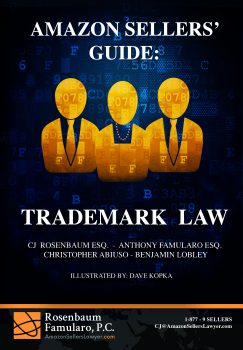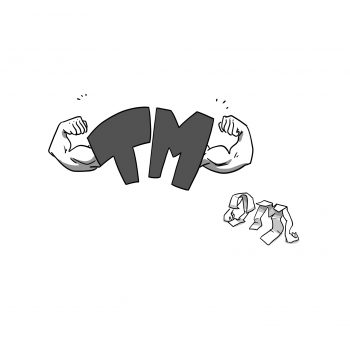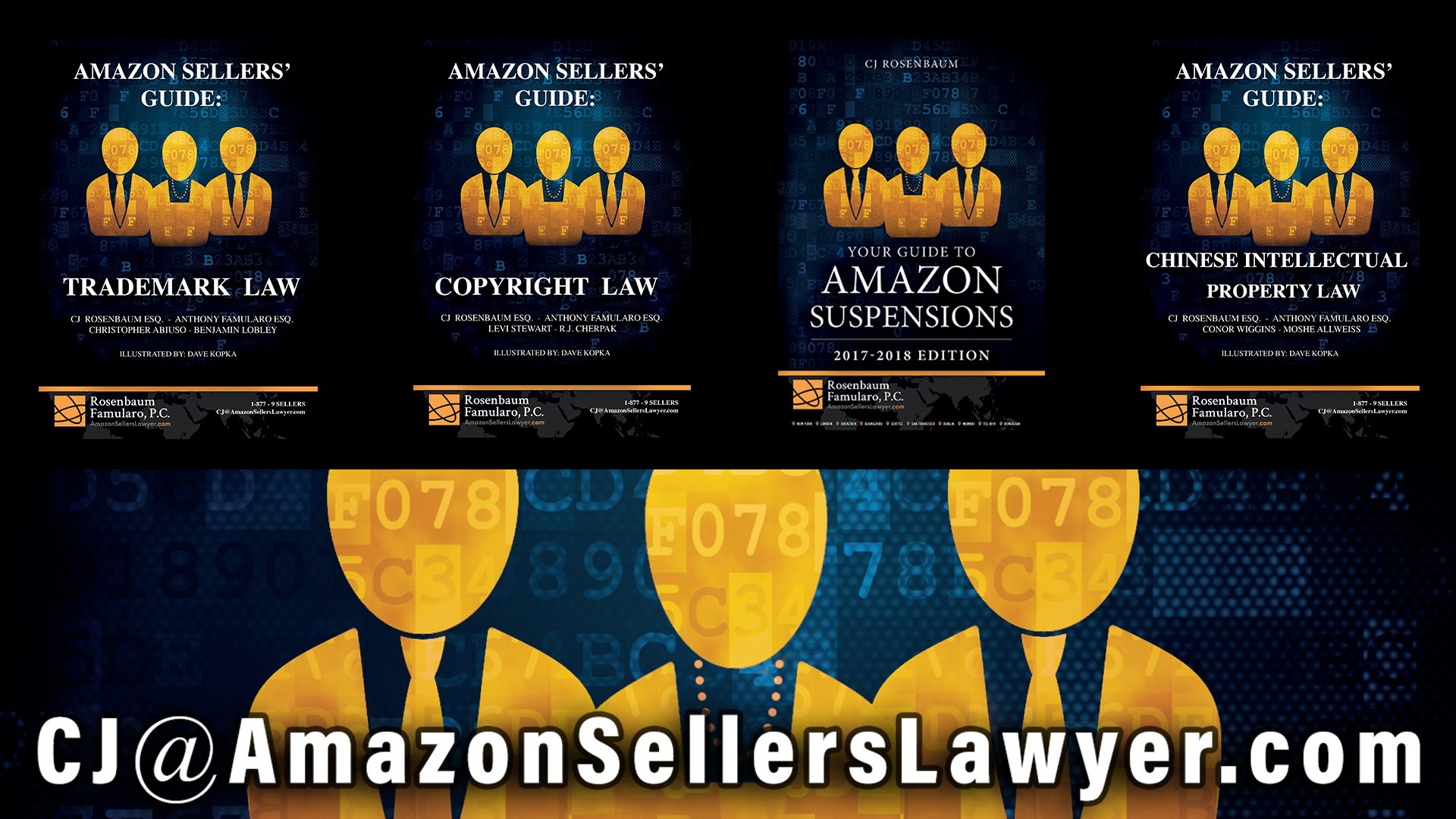
Amazon Sellers’ Guide: Trademark Law
By: CJ Rosenbaum Esq., Anthony Famularo Esq., Christopher Abiuso, and Benjamin Lobley
Chapter 3: How to Design a Trademark ……….. 29
I. Introduction ……….. 29
II. Distinctiveness ……….. 30
III. Acquiring Secondary Meaning ……….. 39
IV. Genericide ……….. 42
Chapter 3: Designing a Registrable Trademark
I. Introduction
 Under the Lanham Act, a trademark is defined as “any word, name, symbol, or device, or any combination thereof” which is used to indicate the origin or producer of specific goods.[1] Trademarks are not relegated to mere sight alone, however. Trademarks that are comprised of sounds (sound marks) are very common and have a history of garnering protection from both the courts and the USPTO through caselaw and registration.[2] Trademarks which rely on a specific color may, on some occasions, be held as valid as well, although with less uniformity or reliability.[3] Even scents have been considered a trademark, albeit in an even smaller number of circumstances and with even less uniformity in decisions.[4] In certain cases, the actual look, or “trade dress,” of the product itself may be considered a variant of a trademark. Trade Dress is discussed in chapter 4.
Under the Lanham Act, a trademark is defined as “any word, name, symbol, or device, or any combination thereof” which is used to indicate the origin or producer of specific goods.[1] Trademarks are not relegated to mere sight alone, however. Trademarks that are comprised of sounds (sound marks) are very common and have a history of garnering protection from both the courts and the USPTO through caselaw and registration.[2] Trademarks which rely on a specific color may, on some occasions, be held as valid as well, although with less uniformity or reliability.[3] Even scents have been considered a trademark, albeit in an even smaller number of circumstances and with even less uniformity in decisions.[4] In certain cases, the actual look, or “trade dress,” of the product itself may be considered a variant of a trademark. Trade Dress is discussed in chapter 4.
As already discussed, for a trademark to be officially registered with the USPTO, the trademark must be distinctive. This applies to all trademark variants, from words to symbols to sound to trade dress. If the USPTO does not find the trademark to be distinctive of the source, it should be rejected by the examiner. Without distinctiveness, therefore, a mark is just a mark, a word is just a word, and a sound is just a sound, without any of the legal protections of a trademark.
Although it could seem a simple task to create a distinctive trademark, oftentimes the goals of making a distinctive trademark and memorable for the sake of consumer attraction and retention are at odds with each other. Without distinctiveness, however, there is no trademark. A careful balance, therefore, must be struck between distinctiveness and sensible designs and choices meant to interface with consumers and customers.
II. Distinctiveness
When a trademark is “distinctive,” it is a reference to how the trademark relates to the brand not the product itself.[5] In other words, a distinctive trademark is a mark which does not refer to the product itself. The mark refers back to the brand or manufacturer.
The accepted variations of distinctive marks are those which are suggestive, arbitrary, or fanciful.[6]
Opposite to distinctive trademarks are trademarks which describe the product itself, of which the two variations are descriptive and generic marks.[7]
Placed in order of least protectible to most protectible, the scale of distinctiveness is as follows:
(1) Generic
(2) Descriptive
(3) Suggestive
(4) Arbitrary, and
(5) Fanciful.[8]
There is no concrete rule to determine what marks are specifically generic or suggestive, simply because of the endless combinations of products and possible marks.[9] Therefore, where a proposed trademark will fall on the spectrum, exactly, will depend primarily on the specific facts of each case.[10]
Fanciful marks are those which are specifically created for the purposes of source identification. In other words, fanciful marks are those which are newly created by the Seller for the sole purpose of representing his or her brand.[11] These marks have no actual meaning outside of their use as a mark.[12] These invented words or terms have no logical relation to the product itself, and do not describe any aspect of the product.[13] For example, “Häagen-Dazs,” the famous ice cream brand, was created entirely from scratch without any real basis in any language.[14] Another example of a fanciful trademark is “Kodak”–it was created specifically to represent the Kodak camera brand.[15]
Arbitrary marks are similar to fanciful marks in a significant way: they do not relate to the product or describe any of its qualities.[16] Where a fanciful word has no dictionary meaning, an arbitrary mark is a common word which is being utilized in an uncommon way.[17] An example of an arbitrary mark is “Apple,” when used as branding for tablets, computers, and phones. “Apple,” though the common name of a popular fruit, does nothing to describe any electronic product on its own. Another example of an arbitrary mark is “Camel,” which, when compared to the cigarette brand it promotes, is completely unrelated to the products it usually finds itself labeling.
A suggestive mark relates to the goods it is applied to only when the consumer must use his or her imagination to make a connection between the mark and the goods.[18] These marks do not openly describe or quantify certain characteristics of the goods, but instead only offer a point from which a consumer may relate the trademark to the goods with the “use [of] imagination or any type of multistage reasoning.”[19] Examples of suggestive marks may include “Mountain Dew,” which could evince the idea of a refreshing liquid, and “Microsoft,” which could remind the consumer of either a microchip or software.
CJ’s Tip: Of all the classifications a trademark may fall under, suggestive marks are perhaps the best to focus on creating for any Seller wishing to create both a strong brand which can both stand up to contentions and challenges of validity and be remembered easily by and stick in the minds of consumers. It is understandable and advisable that Sellers create a brand which is both inherently distinctive (more on that later) and allow the consumer to make a sensible connection between the trademark and the goods. Suggestive marks fulfill both of these aims; they afford consumers a leg to stand on in relating the mark to the product while at the same time remaining inherently distinctive so that registration and possible lawsuits challenging the mark’s legitimacy do not offer much trouble.
Descriptive marks are those which “describe an ingredient, quality, characteristic, function, feature, purpose, or use of the specified goods.”[20] In order to determine whether a mark is descriptive: does the mark signify or represent any quality or component of the subject goods.[21] Since these marks relate to the product, they are the second least-protectible type of mark in the hierarchy of distinctiveness. Examples of descriptive trademarks include “InkJoy,” when in reference to a line of ballpoint pens, and “Windows,” a computer operating system which features digital “windows” allowing users to view files and operate programs.[22]
Finally, at the bottom rung of the distinctiveness hierarchy are “generic marks.” Generic marks include the word which the average consumer would recognize as the common name of the product itself. [23] Generic marks, because they are comprised of the actual word by which the product is known, can never be a trademark because they refer to the goods rather than the source. [24] Terms which could be considered generic may include “Salt,” when affixed to packages filled with salt, or “Granite,” when applied to a company which is solely engaged in the production and shipment of granite.
Also important in the discussion of the spectrum of distinctiveness is the concept of “inherent distinctiveness.” A mark is inherently distinctive if its “intrinsic nature serves to identify a particular source of a product.” [25]
To determine whether a mark is inherently distinctive, the mark will be examined along a series of factors called the Seabrook factors, which are:
(1) a “common” basic shape or design;
(2) unique or unusual in a particular field;
(3) a mere refinement of a commonly adopted and well-known form of ornamentation for a particular class of goods viewed by the public as a dress or ornamentation for the goods; or
(4) capable of creating a commercial impression distinct from the accompanying words. [26]
The Seabrook factors need not all be satisfied to deny a mark’s inherent distinctiveness.[27] These are factors and not a strictly defined ruleset. The satisfaction of a single Seabrook factor can lead an examiner finding a lack of inherent distinctiveness in the subject mark. If the mark is found, based on the Seabrook factors, not to be inherently distinctive, it will either be denied registration or will not be protected if the mark is infringed by a third party.[28]
Where a mark resides on the spectrum of distinctiveness will determine how much protection it will be afforded as a trademark, or even if it can be considered a trademark. Where the mark falls will also determine whether it would likely be found to be inherently distinctive.
Anthony’s Breakdown: Use the chart above to understand where your mark may fall. Suggestive and above, your mark will be inherently distinctive. Below, however, your mark will not be inherently distinctive. You’ll need to either acquire secondary meaning if your mark is descriptive or your mark will never be distinctive enough and will thus never be registrable or protectible.
III. Acquiring Secondary Meaning
 One of the primary effects of a lack of inherent distinctiveness is that it will be barred from being listed in the Principal Register, although it may still be listed in the Supplemental Register. The Principal Register is a federal list of registered trademarks which grant presumptions of ownership in all 50 states, presumptions of trademark validity, and exclusive rights to use the mark.[29] In contrast, while the Supplemental Register allows the Seller to sue for infringement in federal court and protect his or her trademark in a localized area, the protection is not extended to the full 50 states, and it lacks the presumptions bestowed by the Principal Register. [30]
One of the primary effects of a lack of inherent distinctiveness is that it will be barred from being listed in the Principal Register, although it may still be listed in the Supplemental Register. The Principal Register is a federal list of registered trademarks which grant presumptions of ownership in all 50 states, presumptions of trademark validity, and exclusive rights to use the mark.[29] In contrast, while the Supplemental Register allows the Seller to sue for infringement in federal court and protect his or her trademark in a localized area, the protection is not extended to the full 50 states, and it lacks the presumptions bestowed by the Principal Register. [30]
If a mark is not inherently distinctive, it must rely on acquiring secondary meaning to be registered on the Principal Register or to qualify for federal protection against infringement. [31] In other words, a Seller with a mark which is not inherently distinctive must demonstrate that the mark has come to reference himself or herself and not just the product to the general consuming public.[32] Without such a secondary meaning, a mark which is not inherently distinctive will be denied both registration or redressability for infringement.[33]
Under the Lanham Act, there are several types of evidence which may be accepted and reviewed to support the contention that the Seller’s mark has acquired a secondary meaning.[34] This list of possible evidence includes: (1) the prior registration of the same or similar mark on the Principal Register; (2) the use of the mark in commerce for a period of at least five years; and (3) other evidence which would be appropriate and pertinent to finding a secondary meaning. “Other evidence” includes the extent and success of advertisements using the mark, affidavits or declarations asserting that the mark is recognized as a source indicator, and surveys, market research, and consumer studies.[35]
Under § 1052(f) of the Lanham Act, evidence of acquired secondary meaning may be supplied along with the initial application to the examiner.[36] If, however, the Seller’s mark has already been denied registration by the examiner, the Seller may appeal the decision by submitting a claim that the mark has acquired secondary meaning. This claim is called “acquired distinctiveness in the alternative.”[37] This appeal will basically be reviewed in the same way as if the claim of secondary meaning had been submitted initially with the application. Accordingly, the examiner will rely on the same types of evidence the Seller would submit with a normal claim of secondary meaning.[38]
Without inherent distinctiveness, a Seller may find that his or her mark is eligible to be registered on the Supplemental Register. To reiterate, although it is not the Principal Register, the Supplemental Register allows for multiple benefits in addition to those from simply using the mark in commerce.[39] These benefits include: the right to bring infringement suits in federal court; preclusion of the registration of similar marks which are confusing to the Seller’s mark; protection in other countries on the basis of international treaties; and strong evidence for acceptance onto the Principal Register.[40] Those who file their marks on the Supplemental Register are unable to switch their registration to be placed on the Principal Register, but may file an independent application to be registered on the Principal Register once inherent distinctiveness has been achieved and five years of continued use in commerce has passed.
IV. Genericide
The last concept to bear in mind when designing or choosing a trademark is the unfortunate occurrence of “genericide.” Under the Lanham Act, “[a]t any time if the registered mark becomes the generic name for the goods” then the trademark may be challenged via a petition to cancel the mark.[41] In other words, a trademark will lose its protection if it becomes the actual name of the product rather than a reference to the Seller in the eyes of the consuming public.[42] Examples of trademarks which have been killed by genericide include such recognizable words as “yo-yo,” “escalator,” “aspirin,” and “thermos.”[43] Other brands are right on the cusp of genericide and are fighting frantically to keep their trademarks, sometimes with mixed results. For example, Velcro, the producer of a particular type of fasteners, has recently begun pleading to consumers not to use their “VELCRO” trademark as a noun, verb, or adjective to avoid their mark becoming generic. According to them, the correct name for their fasteners is not “velcro strips,” but instead “hook-and-loop fasteners.”[44]
There is no standard ordained by the Lanham Act to determine whether a trademark has been the victim of genericide.[45] Instead, case law has established the precedent of the “public perception” test, which asks: “What do the buyers understand by the word for whose use the parties are contending?”[46] This is, therefore, a situation a Seller needs to be wary of if their trademark has superseded the originally generic term in describing the product. When this happens, the trademark describes the product, not the Seller. This is especially bothersome for sellers who hold a patent in their product and are thus able to prevent the manufacture and sale of said products for a period of 20 years, during which time the consuming public may have come to associate the trademark with the product itself.[47] Genericide can also be an unintended and unfortunate outcome of success.[48] It is, essentially, an eventual penalty for successfully marketing and imprinting the Seller’s trademark into the minds of consumers.[49]
To avoid genericide, Sellers can employ a number of tactics to prevent their trademark from becoming the generic term for the product. First, if the product is one the Seller has invented and patented, the Seller should also introduce a generic term for the product which differs from the trademark.[50] Second, Sellers should never use their trademarks as nouns or verbs.[51] Third, Sellers should remain vigilant and proactive in protecting their brands and policing their use as verbs and nouns by third parties.[52] In short, if the Seller treats his or her trademark as a trademark designating the origin of the product and not the name or function of the product itself, Sellers can generally escape the specter of genericide.
Trademark Law: Chapter 3
[1] 15 U.S.C. § 1127 (2016).
[2] See, e.g., In re General Electric Broadcasting Company, Inc., 199 U.S.P.Q. 560 (T.T.A.B. 1978); Trademark: “Sound Mark” Examples, USPTO (last visited June 16, 2018), https://www.uspto.gov/trademark/soundmarks/trademark-sound-mark-examples (hosting a collection of sound marks which are either registered or pending registration (quoting Qualitex Co. v. Jacobson Products Co., Inc., 514 U.S. 159, 161 (1995) (holding that occasionally “a color will meet ordinary legal trademark requirements”)).
[3] See Daniel Zendel & Dennis Prahl, Making Sense of Trademarks: Colors, Sounds, & Scents, Ladas & Parry (Feb. 16, 1996), https://ladas.com/education-center/making-sense-trademarks-colors-sounds-scents.
[4] See Zendel & Prahl, supra note 58 (citing In re Clarke, 17 U.S.P.Q.2d 1238 (T.T.A.B. 1990) (holding that a floral scent could be considered a trademark when applied to sewing thread)).
[5] Two Pesos, Inc. v. Taco Cabana, 505 U.S. 763, 769 (1992).
[6] Abercrombie & Fitch Co. v. Hunting World, Inc., 537 F.2d 4, 9 (1976).
[7] Id.
[8] Abercrombie & Fitch Co., 537 F.2d at 9.
[9] See U.S. Pat. and Trademark Off., supra note Error! Bookmark not defined., § 1209.01(b).
[10] Id.
[11] Id. § 1209.01(a).
[12] Id.
[13] Lonnie E. Griffith et. al., 87 C.J.S. Trademarks, Etc. § 204 (2018).
[14] Dan Nosowitz, Häagen-Dazs Ice Cream Is From the Bronx—So What’s With the Name?, Atlas OBSUCRA (Sept. 5, 2017), https://www.atlasobscura.com/articles/haagen-dazs-fake-foreign-branding (noting that, while Häagen-Dazs’s founder wanted to create a name that sounded somewhat Danish, the trademark contains an umlaut, which is not present in Danish).
[15] Michael Zhang, Origin and Evolution of Kodak’s Name and Logo, Peta Pixel (Aug. 3, 2011), https://petapixel.com/2011/08/03/origin-and-evolution-of-kodaks-name-and-logo.
[16] U.S. Pat. and Trademark Off., supra note Error! Bookmark not defined., § 1209.01(a).
[17] Nautilus Group, Inc. v. Icon Health and Fitness, Inc., 372 F.3d 1330, 1340 (Fed. Cir. 2004).
[18] U.S. Pat. and Trademark Off., supra note Error! Bookmark not defined., § 1209.01(a).
[19] Entrepreneur Media, Inc. v. Smith, 279 F.2d 1135, 1142 (9th Cir. 2002) (quoting Kendall–Jackson Winery, Limited v. E. & J. Gallo Winery, 150 F.3d 1042, 1047 n. 8 (9th Cir. 1998)).
[20] U.S. Pat. and Trademark Off., supra note Error! Bookmark not defined., § 1209.01(b).
[21] Id.
[22] Note that while “InkJoy” may not have acquired a secondary meaning and thus may not be protectible, “Windows” certainly has and thus is protectible. The concept of acquiring secondary meaning will be discussed in the following section of this chapter.
[23] U.S. Pat. and Trademark Off., supra note Error! Bookmark not defined., § 1209.01(c).
[24] Id.
[25] Two Pesos, Inc. v. Taco Cabana, Inc., 505 U.S. 763, 768 (1992).
[26] U.S. Pat. and Trademark Off., supra note Error! Bookmark not defined., § 1202.02(b)(ii) (citing Seabrook Foods, Inc. v. Bar-Well Foods Limited, 568 F.2d 1342, 1344 (1977).
[27] Id. (citing In re Chippendales USA, Inc., 622 F.3d 1346, 1355 (Fed. Cir. 2010); In re Chevron Intellectual Prop. Grp. LLC, 96 U.S.P.Q.2d 2026, 2028 (TTAB 2010)).
[28] Id.
[29] Kelley Keller, 3 Biggest Differences Between the Principal Register and Supplemental Register for Trademarks, Kelley Keller Esq. (Feb. 2, 2018), http://kelleykeller.com/3-biggest-differences-principal-register-supplemental-register-trademarks.
[30] Id.
[31] See U.S. Pat. and Trademark Off., supra note Error! Bookmark not defined., § 1212.
[32] Id. (quoting Ralston Purina Co. v. Thomas J. Lipton, Inc., 341 F. Supp. 129, 133 (S.D.N.Y. 1972)).
[33] Id.
[34] 15 U.S.C. § 1052(f) (2016).
[35] Id.; U.S. Pat. and Trademark Off., supra note Error! Bookmark not defined., § 1212.06(b)–(d).
[36] See 15 U.S.C. § 1052.
[37] U.S. Pat. and Trademark Off., supra note Error! Bookmark not defined., § 1212.06(c).
[38] Id.
[39] Matthew D. Asbell, Inherent and Acquired Distinctiveness and The Principal and Supplemental Registers for U.S. Trademarks, Ladas & Parry (May 1, 2014), https://ladas.com/education-center/inherent-acquired-distinctiveness-principal-supplemental-registers-u-s-trademarks.
[40] Id. (noting that those on the Supplemental Register lack many of the protections garnered by being placed on the Principal Register, including access to the Madrid Protocol, filing with U.S. Customs to prevent importation of infringing products, having the date of constructive use relate back to the filing date of the application, and constructive notice to others of the trademark’s priority).
[41] 15 U.S.C. 1064(3) (2016).
[42] Id.
[43] John Dwight Ingram, The Genericide of Trademarks, 2 Buff. Intell. Prop. L.J. 154, 154 (2004).
[44] Jack Neff, Velcro Targets Trademark Abusers Again with Singing Lawyers, AdAge (June 5, 2018), http://adage.com/article/cmo-strategy/velcro-trademark-abusers-singing-lawyers/313735/.
[45] Id. at 156.
[46] Id. at 156-57 (quoting Bayer Co. v. United Drug Co., 272 F. 505, 509 (S.D.N.Y. 1921)).
[47] Id. at 158-59.
[48] Id. at 159.
[49] Id.
[50] Id.
[51] Id. at 160.
[52] Id.

For a free copy of one of our books, email us today: CJ@AmazonSellersLawyer.com
- https://amazonsellerslawyer.com/your-guide-to-amazon-suspensions/
- https://amazonsellerslawyer.com/amazon-sellers-guide-trademark-law/
- https://amazonsellerslawyer.com/amazon-sellers-guide-copyright-law/
- https://amazonsellerslawyer.com/amazon-sellers-guide-chinese-intellectual-property-law/
- https://amazonsellerslawyer.com/amazon-law-library/
- https://amazonsellerslawyer.com/your-guide-to-selling-fashion-on-amazon/
